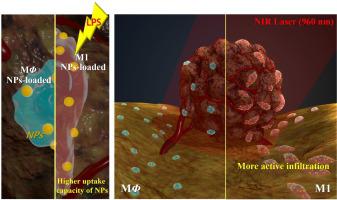Journal of Advanced Research ( IF 11.4 ) Pub Date : 2021-02-01 , DOI: 10.1016/j.jare.2021.01.010 Nu-Ri Im 1 , Taeseok Daniel Yang 2, 3 , Kwanjun Park 4 , Jang-Hoon Lee 2 , Jonghwan Lee 2 , Yoon Hyuck Kim 5 , Jae-Seung Lee 5 , Byoungjae Kim 1, 6 , Kwang-Yoon Jung 1 , Youngwoon Choi 3, 4, 7 , Seung-Kuk Baek 1

|
Introduction
To enhance photothermal treatment (PTT) efficiency, a delivery method that uses cell vector for nanoparticles (NPs) delivery has drawn attention and studied widely in recent years.
Objectives
In this study, we demonstrated the feasibility of M1 activated macrophage as a live vector for delivering NPs and investigated the effect of NPs loaded M1 stimulated by Lipopolysaccharide on PTT efficiency in vivo.
Methods
M1 was used as a live vector for delivering NPs and further to investigate the effect of NPs loaded M1 on PTT efficiency. Non-activated macrophage (MФ) was stimulated by lipopolysaccharide (LPS) into M1 and assessed for tumor cell phagocytic capacity towards NPs
Results
We found M1 exhibited a 20-fold higher uptake capacity of NPs per cell volume and 2.9-fold more active infiltration into the tumor site, compared with non-activated macrophage MФ. We injected M1 cells peritumorally and observed that these cells penetrated into the tumor mass within 12 h. Then, we conducted PTT using irradiation of a near-infrared laser for 1 min at 1 W/cm2. As a result, we confirmed that using M1 as an active live vector led to a more rapid reduction in tumor size within 1 day indicating that the efficacy of PTT with NPs-loaded M1 is higher than that with NPs-loaded MФ.
Conclusion
Our study demonstrated the potential role of M1 as a live vector for enhancing the feasibility of PTT in cancer treatment.
中文翻译:

M1巨噬细胞作为活载体在体内光热治疗纳米粒子中的应用
介绍
为了提高光热治疗 (PTT) 的效率,近年来,一种使用细胞载体进行纳米粒子 (NPs) 递送的递送方法引起了人们的关注和广泛研究。
目标
在这项研究中,我们证明了 M1 激活的巨噬细胞作为递送 NP 的活载体的可行性,并研究了脂多糖刺激的 M1 负载的 NP 对体内PTT 效率的影响。
方法
M1 用作传递 NPs 的活载体,并进一步研究加载 M1 的 NPs 对 PTT 效率的影响。未活化的巨噬细胞 (MФ) 被脂多糖 (LPS) 刺激进入 M1 并评估肿瘤细胞对纳米颗粒的吞噬能力
结果
我们发现,与未活化的巨噬细胞 M Ф相比,M1 每细胞体积的 NPs 吸收能力高 20 倍,肿瘤部位的浸润活性高 2.9 倍。我们在瘤周注射 M1 细胞并观察到这些细胞在 12 小时内渗透到肿瘤块中。然后,我们使用近红外激光以 1 W/cm 2照射 1 分钟进行 PTT 。结果,我们证实使用 M1 作为活性活载体可在 1 天内更快地缩小肿瘤大小,表明 PTT 与 NPs 加载的 M1 的疗效高于 NPs 加载的 M Ф。
结论
我们的研究证明了 M1 作为活载体的潜在作用,可提高 PTT 在癌症治疗中的可行性。











































 京公网安备 11010802027423号
京公网安备 11010802027423号